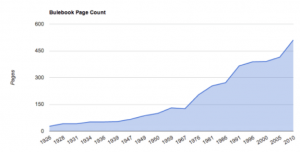ADAM STOLZ—The Bluebook is widely regarded as the “Bible” of legal citation, at least for law school students and legal scholars. As with any religion, adherence to the Bluebook is a sensitive topic and is the center of controversy within the legal community. While the benefits of having a uniform citation system are apparent, tension exists between those who use the Bluebook as a talismanic manual and those who hold the most recent version to be nothing more than a lengthy law student hazing-guide.
According to Judge Richard Posner, the Bluebook has evolved into a “hypertrophy” in that it “has grown far beyond any apparent functional need.” While many share Judge Posner’s criticism of the Bluebook, it is generally accepted that a citation system with some consistency is warranted. Before exploring appropriate alternatives to the Bluebook, a contextual understanding of the principles and purposes underlying the need for legal citation is helpful.
The first edition of the Bluebook was published in 1928 and contained only 28 pages. Since then, it has grown to over 500 pages, as illustrated by the following chart:
Source: Josh Blackman’s Blog
To provide some context, when the Bluebook was introduced, people were still excited about the breakthrough of the Dewey Decimal System; there was certainly no forethought of the Internet. Judge Posner identifies two foundational principles favoring a general system of citation: citations provide the reader with sufficient information to evaluate the source where textual information is borrowed from and to enable the reader to find the reference if he or she wishes to further examine it. Thus, it is sensible that the inaugural Bluebook established a citation format based on the then-contemporary means of accessing sources.
The taxing and tedious method of locating a hardcopy of the Federal Reporter, a treatise, or a law journal remained relatively similar throughout most of the 20th century—a reality many senior faculty members and practitioners like to remind current law students about. Such a process generally required finding the area of the library relevant to the type of source, searching for the author, locating the correct source, confirming the volume number, and uncovering the relevant text. Meanwhile, in the modern Digital Age, a simple Google search will likely produce the exact source that once required a laborious investigation in the depths of a law library. Moreover, the control-find function on computer keyboards allows anyone to quickly locate specific information within an online source. In short, less information is needed to locate a source today when examined against the entailments of legal research when the Bluebook was first published.
Nevertheless, the tedious, rigid citation styles conceived by the Bluebook have only continued to multiply with time. While the Bluebook has responded to modern forums of legal publication (see e.g., Bluebook: Rule 18), legal writers today still must provide citations in the same format that was established to accommodate the nearly obsolete method of checking a source. The blind adherence to such a method leaves even the most sophisticated law students with a sense of puzzlement…and, of course, the aftertaste of light-vanilla roast coffee on his or her breath.
Furthermore, Judge Posner highlights that “uniformity” is not contemplated as an original aim in establishing a system of citation. To the contrary, the Bluebook expressly endorses uniformity as a primary purpose by way of its subtitle: “A Uniform System of Citation.” Judge Posner acknowledges that uniformity is beneficial within a document, but questions whether a lack of standardization across documents would necessarily cause undue inconvenience, especially when furnished at the expense of conforming to the confusing standards offered in the most recent Bluebook edition.
Accordingly, a proper citation should not require more information than necessary to direct a reader to the source. For example, to cite information borrowed from a book, an adequate citation may include no more than the title, author, year of publication, and “pin-cite.” It is significant to note that many legal practitioners in America do not strain to comply with Bluebook citation-requirements, yet successfully file court documents and emerge victorious in trial proceedings. Thus, an informal but sensible standard for providing simple, usable citations may already exist and be self-regulating among practitioners. Additionally, more formal alternative citation methods are available from The Maroon Book, The Universal Citation Guide, and the ALWD Citation Manual. Yet, no citation manual is without flaw. Although a consistent system of citation is useful, stringent uniformity across works is not necessary, especially in the Digital Age and under the hyper-meticulous standard the current edition of the Bluebook promotes.






